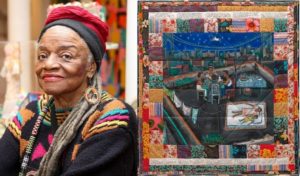“We Flew Over the Bridge: The Memoirs of Faith Ringgold”
A book group especially for art enthusiasts.
September 15, 2022 12:00 pm - 1:00 pm At the Museum and virtually on Zoom
“We Flew over the Bridge: The Memoirs of Faith Ringgold” by Faith Ringgold
Welcome to Museum Reads, the Newport Art Museum’s Art-Themed book group for adults. We meet monthly, at the Museum and virtually, for discussion, and frequently are joined by the author.

In We Flew over the Bridge, one of the country’s preeminent African American artists—and award-winning children’s book authors—shares the fascinating story of her life. Faith Ringgold’s artworks—startling “story quilts,” politically charged paintings, and more—hang in the Studio Museum in Harlem, the Metropolitan Museum of Art, the Guggenheim Museum, the Museum of Modern Art, and other major museums around the world, as well as in the private collections of Maya Angelou, Bill Cosby, and Oprah Winfrey. Her children’s books, including the Caldecott Honor Book Tar Beach, have sold hundreds of thousands of copies.
But Ringgold’s path to success has not been easy. In this gorgeously illustrated memoir, she looks back and shares the story of her struggles, growth, and triumphs. Ringgold recollects how she had to surmount a wall of prejudices as she worked to refine her artistic vision and raise a family. At the same time, the story she tells is one of warm family memories and sustaining friendships, community involvement, and hope for the future.
Museum Reads Notes:
Be sure to register to receive email updates and Zoom links.
For last minute registrations, please call the front desk for the Zoom link at 401-848-8200.
Image: Faith Ringgold, The Sunflower Quilting Bee at Arles 103/425, 1997
About the Author
 Faith Ringgold, née Faith Jones, was born October 8, 1930, in New York, New York. She is an American artist and author famous for her innovative quilted narrations that communicate her political beliefs.
Faith Ringgold, née Faith Jones, was born October 8, 1930, in New York, New York. She is an American artist and author famous for her innovative quilted narrations that communicate her political beliefs.
Jones grew up in New York City’s Harlem district, and while still in high school, decided to become an artist. She attended City College of New York, where she received a degree in fine arts and education (1955) and an M.A. in fine arts (1959). In the mid-1950s Jones started teaching art in New York public schools, a job she held until the 1970s. After Jones married her second husband, Burdette Ringgold, in 1962, she began using his name professionally.
By the 1960s Ringgold’s work had matured, reflecting her burgeoning political consciousness, study of African arts and history, and appreciation for the freedom of form used by her young students. She began a body of paintings in 1963 called the American People series, which portrays the civil rights movement from a female perspective. One of the best-known and perhaps most-unsettling is American People #20: Die (1967), a bold representation of contemporary race riots. Inspired by Pablo Picasso’s Guernica (1937), the mural presents a tangle of Black and white bodies, their doll-like eyes wide in terror, and their heads and matching attire bloodied. The Museum of Modern Art (MoMA) in New York City acquired the work in 2016 and caused a stir three years later when it placed the painting near Picasso’s Les Demoiselles d’Avignon (1907) in an effort to diversify the presentation of its collection.
In the 1970s Ringgold lectured frequently at feminist art conferences and actively sought the racial integration of the New York art world. She originated a demonstration against the Whitney Museum of American Art that led to the inclusion of works by Betye Saar and Barbara Chase-Riboud in the 1972 sculpture biennial, and she helped win admission for Black artists to the exhibit schedule at the Museum of Modern Art. In 1970 Ringgold and one of her daughters founded the advocacy group Women Students and Artists for Black Art Liberation. She also began to explore different types of media, including soft sculptures and masks. In 1972 she started collaborating with her mother, Willi Posey Jones, who was a fashion designer, to create the Slave Rape series of paintings, which were inspired by Tibetan thang-kas that she viewed on a visit to museums in Amsterdam. They also worked together to make masks for the Family of Women series (1973–74).
In the 1980s Ringgold began working on “story quilts,” which became some of her most renowned works. She painted these quilts with narrative images and original stories set in the context of African American history. Her mother frequently collaborated with her on them. These works included Who’s Afraid of Aunt Jemima? (1984), Sonny’s Quilt (1986), and Tar Beach (1988), the latter of which Ringgold adapted into a children’s book (1991) that was named a Caldecott Honor Book in 1992. It tells the story of a young Black girl in New York City who dreams about flying. Ringgold’s later books for children included Aunt Harriet’s Underground Railroad in the Sky (1992), My Dream of Martin Luther King (1995), Harlem Renaissance Party (2015), and We Came to America (2016). Her memoirs, We Flew over the Bridge, were published in 1995.
In the 21st century she continued to work on quilts and on various commissions, and in 2022 the New Museum, New York City, held a major retrospective of her work entitled “Faith Ringgold: American People.”
This event is made possible by your support of the Annual Fund.